Pro Kenmore Plant Care Plan: Prevent Summer Garden Loss
Quick Summer Garden Survival Tips:
- Water Deeply, Less Often: Encourage strong roots by soaking the soil 6-8 inches down when watering.
- Mulch Generously: Apply 2-3 inches of organic mulch to retain moisture, cool soil, and suppress weeds.
- Fertilize Gently: Avoid heavy feeding in peak heat; focus on soil health and light feeding for containers.
- Patrol for Pests: Regularly check plants and use eco-friendly methods for control.
Need professional help keeping your garden thriving? Request a free quote today!
Introduction: Summer in Ottawa – More Than Just Beavertails and Canal Skates!
Hey there, fellow Ottawa-area gardeners! Summer in the capital region is fantastic, isn't it? The patios are buzzing, the festivals are in full swing, and we've swapped our canal skates for... well, maybe just swatting mosquitoes! While winter gets the iconic activities, summer brings its own set of challenges, especially for our beloved gardens. That intense heat, the sticky humidity, and those sudden, dramatic thunderstorms can really put our plants – and our patience – to the test. Keeping your flower beds vibrant and your vegetable patch producing can feel like a bit of a battle against the elements sometimes.
That's exactly why we've put together the Kenmore Plant Care Plan! Think of it as your go-to guide for navigating the unique hurdles of summer gardening right here in our corner of the world. Whether you're nurturing delicate annuals in Kenmore, trying to keep your lawn green in nearby Greely, or perfecting your landscape design out in Metcalfe, the principles of smart summer care are key. We'll share practical tips on everything from efficient watering techniques to boosting soil health and keeping common pests from crashing your garden party. Our goal is simple: to help your garden not just survive the Ottawa summer, but absolutely thrive. Let's get started!
Decoding Ottawa's Summer Sizzle: Climate, Clay, and Community Context
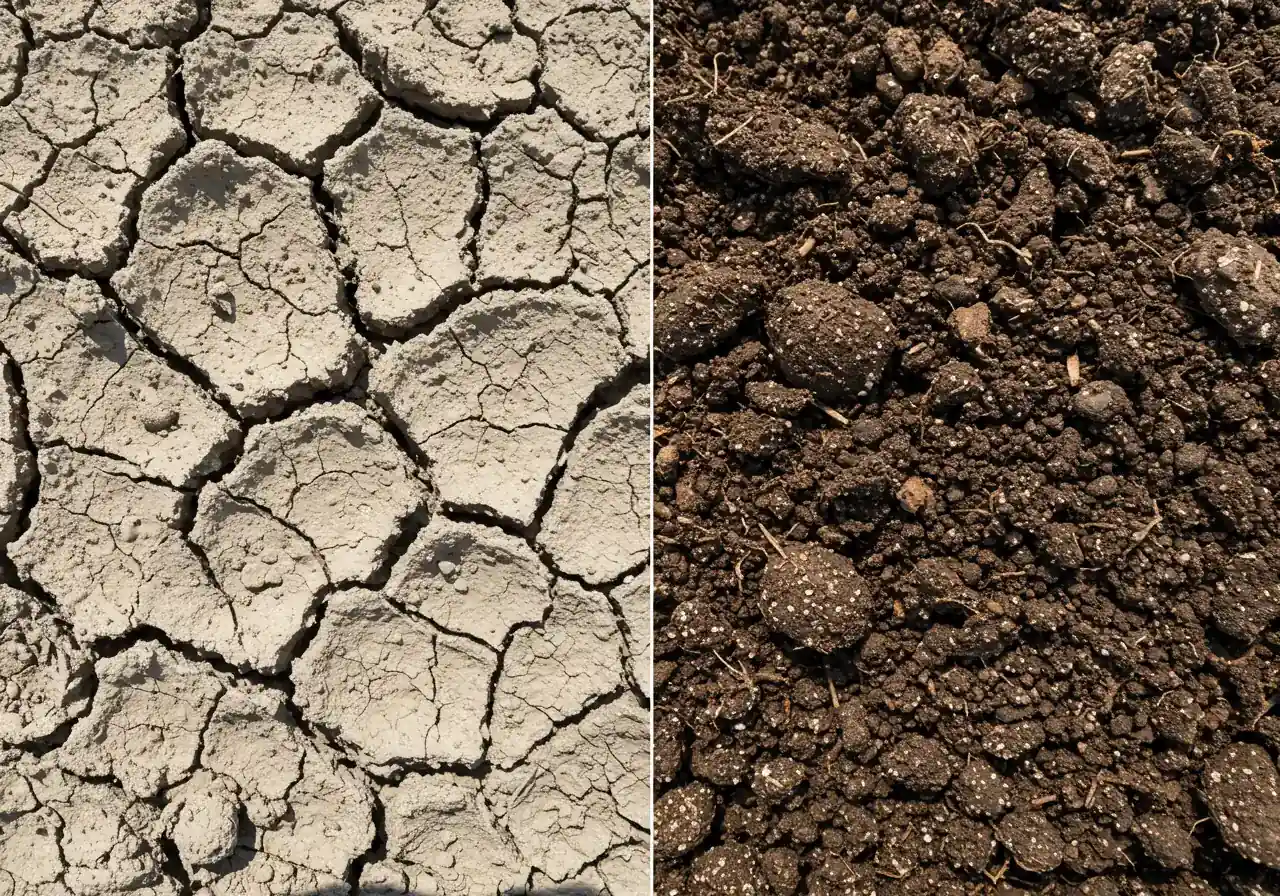
Alright, let's talk about summer in the Ottawa region. It’s glorious, no doubt! But as any gardener from Barrhaven to Kenmore knows, our summers pack a unique punch. We swing from pleasant warmth to sizzling heat waves faster than you can say "pass the sunscreen!" Understanding this specific climate, our often-stubborn soil, and how they interact is key to a happy summer garden.
First up: the weather rollercoaster. Ottawa summers often bring intense heat and humidity. Think sticky days where the air feels thick enough to chew. This combo can really stress out our plants. They might wilt dramatically during the day (even if the soil is damp!), and vegetables like lettuce can "bolt" – meaning they flower and go bitter prematurely. High humidity also creates the perfect party atmosphere... for fungal diseases like powdery mildew. Keep an eye out! Then, just when things get really dry, BOOM – a classic Ottawa thunderstorm rolls through, dumping loads of rain in a short time. While welcome, this can lead to runoff, soil compaction, and even physical damage to delicate plants. Look for weather updates from reliable sources like Environment Canada Ottawa.
Now, let's dig into the dirt – literally. Much of the Ottawa area, including spots like Osgoode and Nepean, sits on heavy clay soil. If you've ever tried digging after a dry spell, you know it can feel like chipping concrete. Clay particles are tiny and pack together tightly. The upside? Clay holds onto water and nutrients like a champ. The downside? It drains very slowly. After a heavy rain, it can stay waterlogged, potentially suffocating plant roots. When it finally dries out in the summer heat, it shrinks, cracks, and becomes rock hard. It's a bit of a diva, that clay.
So, how do you garden successfully with this dynamic duo of humid heat and heavy clay?
- Water Wisely: Because clay holds water, you don't need to water as often as sandy soils. But when you do water, water deeply. Encourage roots to grow down where the moisture lasts longer. Avoid shallow, frequent watering, which encourages shallow roots vulnerable to heat stress.
- Mulch is Your Friend: Applying a few inches of organic mulch (like shredded bark or straw) is a game-changer. It helps keep the soil cooler, reduces evaporation (less watering!), prevents the clay from baking into a brick, and suppresses weeds. Win-win-win! Learn more about our mulching and edging services.
- Improve Your Soil: Clay isn't bad soil, it just needs some help. Regularly adding organic matter like compost improves its structure over time, making it drain better and easier to work. This isn't an overnight fix, but it's the best long-term strategy. Explore our soil preparation techniques. If you're battling serious clay issues, consider building up rather than digging down. We've got some great advice on installing raised garden beds on clay soil that can make a huge difference.
- Choose Plants Carefully: Some plants handle clay and heat better than others. Look for varieties known to be tolerant of these conditions. And remember how your garden performed last year – keeping fall garden records is super helpful for choosing winners next season.
- Think Beyond Plants: Creating a pleasant atmosphere can make gardening more enjoyable even on hot days. Consider adding small yard water features; the sound is relaxing, and they can attract beneficial insects.
- Prepare in Advance: A healthy plant is a resilient plant. Giving your garden a good start, including ensuring proper spring fertilizing for your lawn, helps it withstand summer stresses better.
Whether you're tending a large yard in Manotick or a smaller plot in Kenmore, these summer challenges are pretty universal across our region. Understanding the 'why' behind the wilting or waterlogging helps you apply the 'how' of effective summer garden care. And hey, if tackling that clay or figuring out the perfect watering schedule feels overwhelming, remember there's help available. Exploring our range of landscaping services can connect you with pros who know Ottawa's climate and soil inside out. For local guidance, check resources like the Master Gardeners of Ottawa-Carleton.
Watering Wisdom: Quenching Thirst Without Drowning Dreams
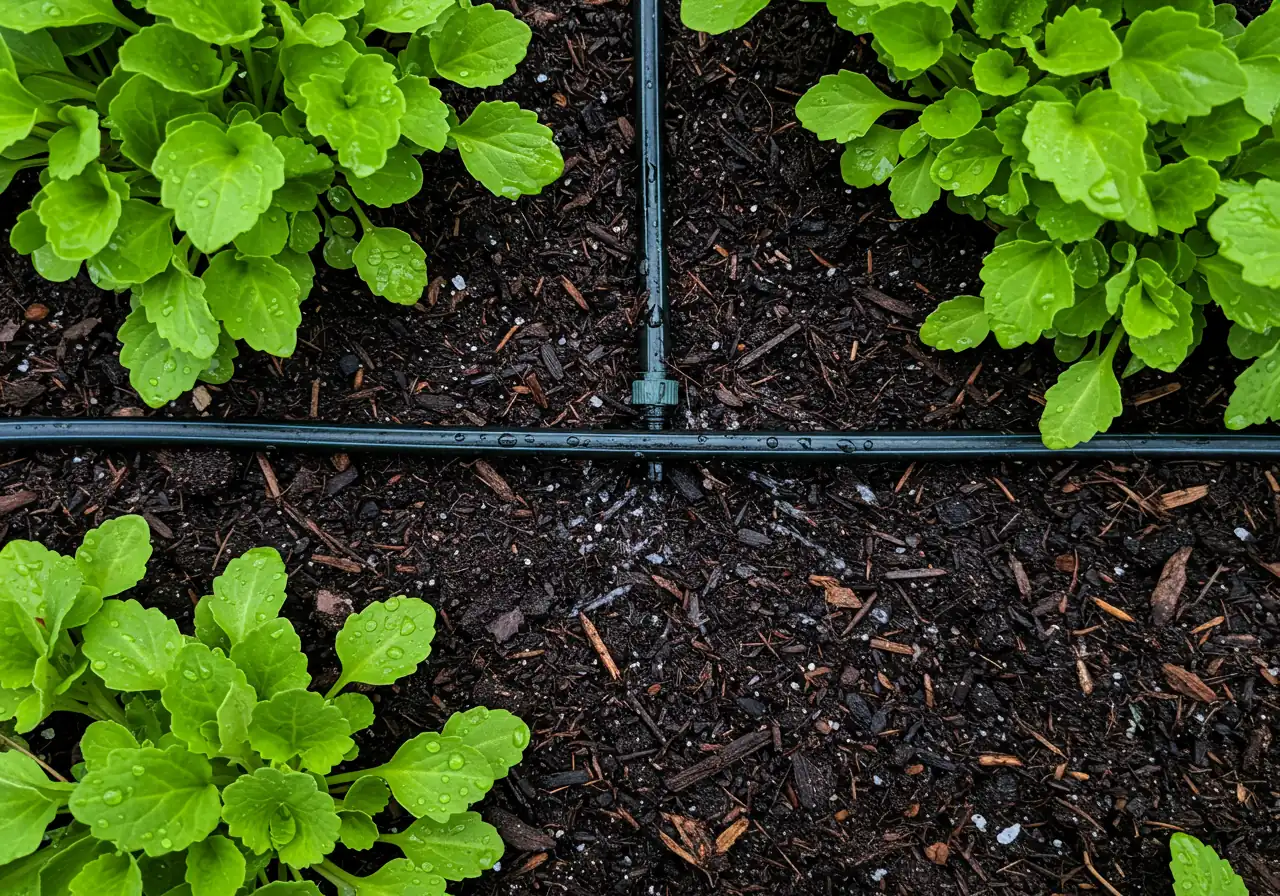
Watering your garden in the Ottawa summer can feel like a tricky dance. Too little, and your prize-winning petunias start looking sadder than a dropped ice cream cone. Too much, especially in our common clay soil, and you might accidentally be giving your plant roots swimming lessons they never asked for! Finding that "just right" Goldilocks zone is key to quenching their thirst without drowning their dreams (or your landscape design ambitions). Let's dive into some watering wisdom!
Think of it this way: you want to encourage your plants to grow deep, strong roots. Why? Because deeper soil stays moist longer, even when the sun is blazing. Shallow, frequent watering encourages roots to stay near the surface, making them super vulnerable to drying out. So, the golden rule is: Water deeply, less often. Aim to moisten the soil down to at least 15-20 cm (6-8 inches) each time you water. This is especially important for establishing perennials and keeping that lawn care game strong.
The best time to water is early morning. The air is cooler, so less water evaporates before it can soak in. Plus, your plants get a nice drink to prepare for the heat of the day. Watering in the evening is okay, but damp leaves overnight can sometimes encourage fungal diseases – not ideal!
But how do you know when it's time to water? Forget guesswork; get your hands dirty! Here’s a simple test:
- The Finger Test: Stick your index finger into the soil near your plants, about knuckle-deep (around 5 cm or 2 inches).
- Feel: If the soil feels dry at that depth, it's likely time to water. If it feels damp or cool, you can probably wait another day or two.
- Check Different Spots: Remember that soil in full sun will dry out faster than soil in shade. Check a few different areas in your flower beds and veggie patch.
How you deliver that water matters too:
- Hand Watering (Watering Can/Hose): Great for containers and hitting specific spots. Can be time-consuming for larger areas. Make sure you're watering the soil, not just the leaves!
- Sprinklers: Convenient for lawns, but can be inefficient. A lot of water can evaporate on hot, windy days, and water often lands on leaves instead of the soil. If you use sprinklers, run them early in the morning and long enough to soak deeply.
- Soaker Hoses/Drip Irrigation: These are the champs of efficiency! They deliver water slowly and directly to the root zone, minimizing evaporation and runoff. Perfect for flower beds, vegetable gardens, and hedges. Setting up a system might feel daunting, but it saves water and time in the long run. If installing drip irrigation seems complex, exploring expert landscaping services can connect you with pros who handle these setups.
Being water-wise is good for your plants, your wallet, and the Rideau River! Check City of Ottawa guidelines for current water usage recommendations.
- Mulch, Mulch, Mulch! We mentioned it before, but it bears repeating. A 5-7 cm (2-3 inch) layer of organic mulch (like shredded bark or compost) is your best friend. It dramatically reduces evaporation, keeps soil temperatures stable, and suppresses weeds that compete for water. Keeping the garden tidy makes mulching easier; a thorough fall clean-up, perhaps using a Kenmore yard cleanup service or a Metcalf property cleanup service depending on your location, sets the stage for effective spring mulching. Ensuring the ground is clear with a general city-wide yard cleanup service also helps water penetrate evenly.
- Choose Wisely: Consider adding some drought-tolerant native plants to your landscape design. They're naturally adapted to our Ottawa climate swings.
- Group 'Em Up: Place plants with similar water needs together. This way, you aren't overwatering drought-lovers while trying to quench thirsty annuals.
- Rain Barrels: Collect that free water falling from the sky! It's perfect for watering containers and garden beds.
- Healthy Soil: Improving your soil health with compost helps clay soil drain better and retain moisture more effectively – a win-win for water management. Good watering practices are foundational, but they work best as part of overall garden care, including regular tidying which can be simplified with professional property clean-up. For specific help, consider Ottawa property cleanup or city property cleanup services.
Watering doesn't have to be a chore or a mystery. By understanding your soil (hello, clay!), applying smart watering techniques like watering deeply and less often, and using conservation tips, you can keep your Kenmore containers colourful and your Metcalfe maples happy all summer long. Happy gardening!
Mulch Ado About Something: Your Garden's Summer Sunscreen & Security Blanket
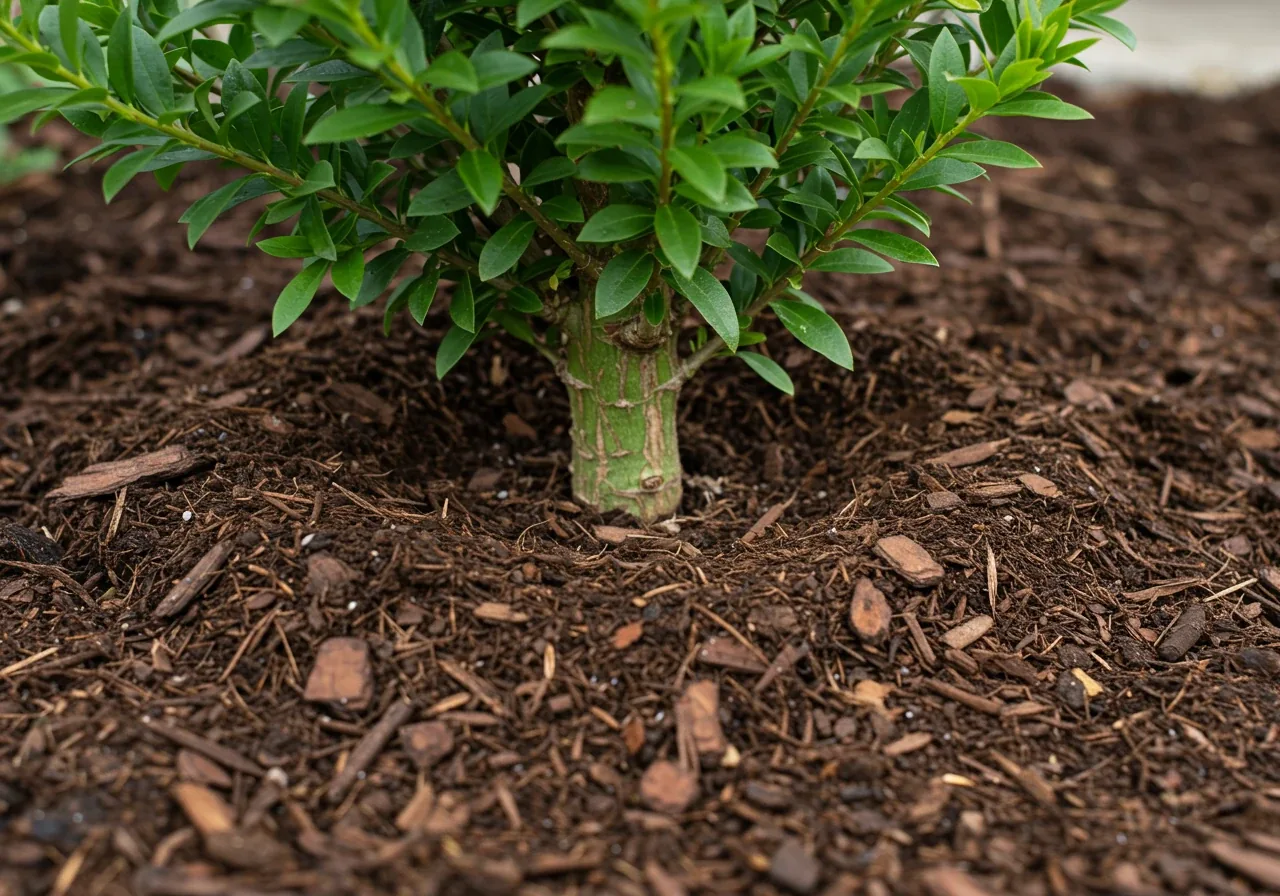
Alright, let's talk mulch! It might not sound like the most glamorous gardening topic, but trust us, it’s a game-changer, especially during our unique Ottawa summers. Think of mulch as your garden's very own multi-tasking superhero cape: it acts like sunscreen on scorching days and a security blanket against weeds and water loss. If your garden beds look a little... well, *naked*, then this section is for you!
Why make mulch ado about this stuff? Because applying a good layer of mulch offers a heap of benefits that directly combat Ottawa's summer stresses:
- Moisture Manager: Remember our chat about watering wisdom? Mulch is key! It acts like a lid on your soil, dramatically slowing down evaporation caused by the summer sun and wind. This means you water less, saving time, water, and money. Critical for keeping plants happy between those dramatic thunderstorms!
- Temperature Tamer: Bare soil heats up fast under the July sun, practically cooking delicate roots. Mulch acts as an insulator, keeping the soil health more stable – cooler in the summer heat and warmer during cooler nights. Your plant roots will thank you!
- Weed Warrior: A good layer of mulch blocks sunlight from reaching weed seeds, significantly reducing how many pesky invaders sprout in your flower beds. Less weeding? Yes, please!
- Soil Superhero: As organic mulch breaks down, it adds valuable organic matter to the soil. This is fantastic news for our common clay soil here in areas like Greely or Osgoode, helping improve its structure, drainage, and nutrient content over time.
- Finishing Touch: Let's be honest, mulch just makes landscape designs look neat and tidy. It gives beds a uniform, polished appearance.
Choosing Your Mulch Weapon:
Not all mulches are created equal. Here’s a quick rundown:
| Mulch Type | Pros | Cons |
|---|---|---|
| Shredded Bark (Cedar, Pine) | Looks great, smells nice, lasts well, good weed suppression. | Can fade, may slightly acidify soil (usually minor). |
| Wood Chips | Slower to break down, can be sourced locally. | Fresh chips can tie up nitrogen temporarily (use aged). |
| Compost | Excellent soil conditioner, adds nutrients, looks rich. | Breaks down faster, may contain weed seeds if not fully composted. |
| Shredded Leaves/Straw | Free organic matter (leaves), straw reflects heat. | Can blow around, straw may have grain seeds. |
| Inorganic (Gravel, Stone) | Permanent, don't decompose. Good for some styles. | Don't improve soil, can radiate heat, hard to plant in later. |
Feeling unsure about what's best for your specific needs? Choosing the right covering is important. We have a handy guide to help you navigate the options, check out our tips on selecting the right landscaping materials.
How to Mulch Like a Pro:
Applying mulch isn't complicated, but doing it right makes a difference:
- Weed First! Seriously, don't skip this. Mulch is great at preventing weeds, but not great at killing established ones. Give yourself a clean slate. If the area is overgrown, consider getting help with a thorough tidying first; our professional property clean-up services can whip beds into shape before mulching. Check specific services for Metcalfe or Marionville if needed.
- Apply the Right Amount: Aim for a layer about 5-7 cm (2-3 inches) deep. Too thin, and it won't do much. Too thick, and you risk suffocating roots or creating a haven for slugs.
- The Donut, Not the Volcano: When mulching around trees and shrubs, pull the mulch back slightly from the base of the trunk or stems. Piling it directly against the plant can trap moisture, leading to rot and encouraging pests or diseases. Think donut shape, not a mulch volcano!
- Spread Evenly: Use a rake or your hands to create a nice, even layer over the entire bed.
Whether you have sprawling gardens in Manotick or more contained beds in Nepean, the principles are the same. Using organic mulches is an eco-friendly way to boost your garden's resilience and beauty.
Mulching is one of the best investments you can make in your garden's summer health and your own sanity (less watering and weeding!). Got questions about the best mulch type for your specific plants or soil, or maybe you need a hand getting that mulch delivered and spread? Don't hesitate to get in touch with us. We're happy to help! We take your privacy seriously when you reach out; you can review our commitment to protecting your information in our privacy policy. And if you've used professional help for mulching or other yard work, sharing your experience helps others; you can see what clients say or leave your own thoughts via our estimate feedback form. Happy mulching!
Spring Prep
Clean up beds, amend soil with compost, and apply initial mulch layer after soil warms up.
Early Summer
Check mulch depth, top up if needed (aim for 2-3 inches). Ensure no "mulch volcanoes" around stems.
Mid-Summer
Monitor moisture levels under mulch. Spot weed as necessary (should be minimal!).
Late Summer/Fall
Mulch continues to protect soil. Allow organic mulches to start breaking down, feeding the soil.
Feed Me, Seymour! (But Gently): Smart Summer Fertilizing
Okay, gardeners, let's talk plant food! Your annuals are blooming their hearts out, your veggies are (hopefully) sizing up, and even your trusty perennials are putting on a show. It's tempting to think, "More food equals more flowers/fruit, right?" Just like Seymour wanting to keep his unusual plant happy in Little Shop of Horrors, we want to nourish our gardens. But hold your fertilizer scoops! During the peak heat of an Ottawa summer, pushing plants too hard with food can sometimes do more harm than good. Think of it less like a buffet and more like offering a refreshing, light snack.
Why Easy Does It in the Summer Heat?
When temperatures soar, many plants naturally slow down their growth to conserve energy and water. They're basically in survival mode, trying to cope with the heat stress. Force-feeding them with high-nitrogen fertilizers during this time is like making someone run a sprint after they’ve already finished a marathon in 30-degree humidity – it can lead to serious burnout!
Over-fertilizing, especially with synthetic, quick-release types when it's hot and dry, carries risks:
- Fertilizer Burn: This is like a sunburn for your plants. Excess fertilizer salts draw moisture out of the plant roots and leaves, causing brown, crispy edges or even killing the plant. Ouch!
- Weak Growth: You might stimulate lots of leafy growth, but it can be weak, floppy, and more attractive to pests and diseases.
- Wasted Effort & Money: If the plant isn't actively growing and taking up nutrients, that expensive fertilizer might just sit there or get washed away by the next big Ottawa thunderstorm, potentially polluting waterways.
- Stress Magnifier: Instead of helping, you might just add another layer of stress to an already heat-stressed plant.
So, When and What Do You Feed? A Simple Summer Guide:
Think gentle and targeted:
- Container Plants (Annuals & Veggies): These guys are working hard in a limited amount of soil and are often heavy feeders. They may need regular feeding throughout the summer, but switch to a diluted liquid fertilizer (like fish emulsion or seaweed blend) applied every 2-4 weeks. Always water the container thoroughly before applying liquid fertilizer to avoid shocking the roots.
- Vegetable Gardens (In-Ground): Established veggie plots usually benefit more from good soil health built up over time. If plants look pale or stunted (and you know it's not a water issue), a light side-dressing of compost or a sprinkle of slow-release organic granular fertilizer mid-summer might be okay. Avoid heavy nitrogen boosts, especially for fruiting plants like tomatoes once they start setting fruit (too much nitrogen = lots of leaves, fewer tomatoes).
- Established Perennials & Shrubs: Most established perennials and shrubs in your flower beds don't need summer feeding if they were fertilized in the spring or are growing in healthy soil amended with compost. Let them ride out the heat. Pushing new growth late in the season can make them vulnerable to winter damage.
- Lawns: Resist the urge to heavily fertilize your lawn in peak summer. Applying nitrogen in the heat can scorch the grass and encourage disease. The best times for lawn care feeding are typically spring and, crucially, late fall in the Ottawa region. Focus on proper watering and mowing height during summer.
Gentle Food Choices:
- Compost & Compost Tea: The ultimate slow-release food. Top-dressing beds with compost provides a gentle nutrient boost and improves soil health. Compost tea offers a mild liquid feed. Getting the foundation right is key; you can learn more about expert soil preparation advice to minimize the need for constant feeding.
- Slow-Release Organic Fertilizers: These break down gradually, feeding plants gently over time. Look for granular options derived from natural sources.
- Liquid Seaweed/Fish Emulsion: Great for a quick but mild boost, especially for containers. Dilute them properly (usually more diluted than package instructions suggest in summer) and apply to the soil, not just the leaves.
Practical Tips for Summer Feeding (If Necessary):
- Water First, Feed Later: Always water plants thoroughly before applying any fertilizer, liquid or granular. Dry roots are easily burned. Water again lightly after applying granular fertilizer to help it start dissolving.
- Read the Label & Go Easy: Follow package directions, but err on the side of using less than recommended during summer heat. You can always add a tiny bit more later if needed; you can't easily take it away!
- Avoid Midday Sun: Apply fertilizers in the cooler morning or evening hours, not under the blazing midday sun.
- Focus on Soil: Remember, healthy soil is the best "fertilizer." Regular additions of organic matter, like compost, achieved through proper bed prep or even as part of services like mulching and edging services, build a resilient foundation. A tidy garden also ensures nutrients reach the plants; if things are overgrown in areas like Metcalfe or Marionville, consider a targeted cleanup like a Metcalfe yard cleanup service or getting help with Marionville property cleanup before amending the soil.
Summer gardening in places like Manotick or Barrhaven is about working with the conditions, not against them. Sometimes, the smartest way to "feed" your plants is simply ensuring they have consistent moisture, good airflow, and healthy soil. If you're ever unsure about your garden's specific needs or want tailored advice, feel free to reach out. We handle your information carefully, as outlined when you review our privacy policy. Happy (gentle) feeding!
Summer Container Feeding
Containers dry out faster and leach nutrients quicker. Use a diluted liquid organic fertilizer (fish/seaweed) every 2-4 weeks. Water thoroughly *before* feeding. Check moisture daily in heat waves.
In-Ground Bed Nutrition
Focus on building soil health with compost. Most established perennials/shrubs don't need summer feeding. If veggies look pale, a light side-dress of compost or slow-release organic fertilizer is okay. Avoid high nitrogen.
Summer Lawn Care Focus
Avoid fertilizing heavily in peak summer heat to prevent burn and disease. Water deeply when needed. Mow higher (leave clippings for nutrients). Major feeding is best in spring and late fall.
Bug Off! Proactive Pest & Disease Patrol for Peaceful Plants
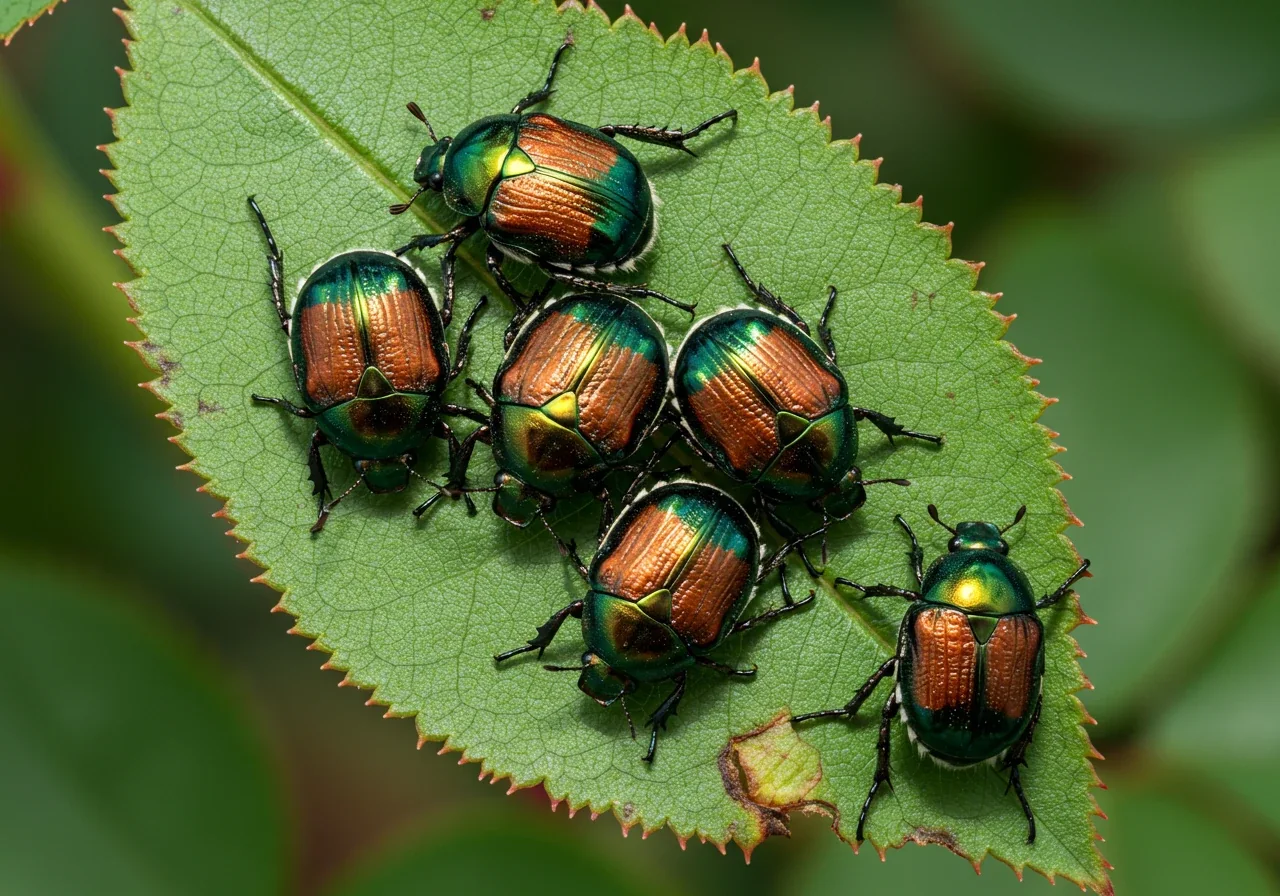
Okay, let's face it – sharing your beautiful Kenmore garden with uninvited guests isn't exactly part of the plan. Just when your roses are looking perfect, or your beans are finally setting, along come the six-legged party crashers or sneaky spots that threaten your gardening peace. Summer in Ottawa brings warmth and growth, but it also rolls out the welcome mat for a variety of pests and diseases. Don't despair! With a little proactive patrolling and some smart strategies, you can keep most problems small and your plants happy. Think of it as neighbourhood watch, but for your landscape!
Meet the Usual Suspects (Don't Worry, We Have a Plan!)
Every region has its common garden nuisances. Here in the Ottawa area, you might encounter:
- Aphids: Tiny, pear-shaped insects (often green, black, or brown) that cluster on new growth, sucking the life out of plants and leaving sticky "honeydew."
- Japanese Beetles: These metallic green and copper beetles are voracious eaters, skeletonizing leaves (especially roses, grapes, and hibiscus). They seem particularly fond of areas like Russell and Winchester some years! Ugh. Learn about managing invasive species from the Invasive Species Centre.
- Slugs and Snails: Slimy critters that love damp conditions and munch holes in leaves, especially hostas and leafy greens. They often work the night shift.
- Powdery Mildew: Looks like someone dusted your plant leaves (especially on phlox, bee balm, and squash) with white powder. Thrives in humid conditions with poor airflow.
- Black Spot: Primarily a rose problem, causing black spots on leaves, which then yellow and drop.
Prevention: Your Garden's Best Defence
The absolute best way to deal with pests and diseases is to make your garden less inviting to them in the first place. This is the heart of Integrated Pest Management (IPM) – a common-sense approach that prioritizes prevention and eco-friendly solutions.
- Start Strong: Healthy plants are less susceptible. This begins below ground with good soil. Ensuring you follow healthy soil preparation techniques gives your plants the foundation they need to resist problems.
- Right Plant, Right Place: Choose varieties suited to our Ottawa climate and your specific garden conditions (sun/shade, soil type). Some plants are naturally more resistant to certain diseases.
- Water Wisely: As we discussed earlier, avoid soggy soil and wet leaves overnight, which invite fungal diseases and slugs. Water the soil, not the plant tops, ideally in the morning.
- Give 'Em Space: Good air circulation helps prevent fungal diseases like powdery mildew. Don't overcrowd plants, and prune shrubs appropriately to open them up.
- Keep it Clean: Remove dead or diseased leaves and stems promptly. Clean your gardening tools (pruners, shovels) between plants, especially if you've dealt with disease, to avoid spreading trouble. This basic tidiness is a core part of regular garden maintenance and makes a huge difference. Consider our city garden maintenance service or specific location services like Metcalfe garden clean up, Marionville garden clean up, or city garden clean up service.
Your Weekly Plant Patrol Checklist:
Grab your morning coffee (or evening lemonade) and take a 5-10 minute stroll through your garden a couple of times a week. It's relaxing and effective!
- Look Under: Gently lift leaves and check their undersides – aphids and other pests love hiding there.
- Check New Growth: Pests often target tender new shoots and buds.
- Scan Stems & Flowers: Look for clusters of insects, weird spots, or holes.
- Inspect the Soil Surface: Check for slugs, snails, or cutworms (especially around seedlings).
- Note the Overall Vibe: Are plants looking stressed, yellowed, wilted (when soil isn't dry), or just "off"? Early detection is key!
Eco-Friendly Counterattacks: Sending Pests Packing (Gently)
Spotted a problem? Don't panic and reach for the harshest chemical spray first! Try these eco-friendly options:
- The Squish & Flick: Yep, sometimes the best method for small numbers of aphids or beetles is simply squishing them or flicking them into a bucket of soapy water. Satisfying, in a slightly weird way.
- Water Power: A strong jet of water from the hose can dislodge aphids and spider mites. Do it early in the day so leaves dry quickly.
- Soapy Solutions: Insecticidal soap (buy it pre-made or research DIY recipes carefully) disrupts the outer layer of soft-bodied insects like aphids. It must contact the pest directly to work.
- Horticultural Oil: Used primarily during the dormant season but sometimes in summer (read labels carefully!), it smothers overwintering pests and eggs.
- Barriers & Traps: Copper tape around pots can deter slugs. Sticky traps can catch flying insects (but may also catch beneficials, so use thoughtfully). Japanese beetle traps can sometimes attract more beetles to your yard, so place them far from prized plants if you use them.
- Prune it Out: For diseases like black spot or powdery mildew, promptly remove affected leaves or stems. Dispose of them in the garbage, not the compost. Improve air circulation.
When Problems Persist
Sometimes, despite your best efforts, a pest or disease issue gets out of hand. Maybe it's a large infestation across your whole landscape, or a recurring problem you can't seem to solve. If you're feeling overwhelmed, seeking professional help is a smart move. Companies that offer a city-wide garden maintenance service often have experience identifying and managing common Ottawa-area pests and diseases using IPM principles. They can assess the situation and recommend appropriate action. If you're considering hiring help, it's good practice to understand the scope of services; feel free to review our terms and conditions for clarity on service agreements. At Clean Yards, we believe in responsible garden care; you can learn more about us and our approach. You can also visit our Google My Business page for reviews and info.
Keeping pests and diseases in check is an ongoing part of gardening, but it doesn't have to be a constant battle. By being observant, acting preventatively, and choosing the gentlest effective solutions first, you can maintain a healthy, thriving, and peaceful garden sanctuary all summer long. Happy patrolling!
Common Summer Pest Activity (Conceptual)
*Relative activity levels during peak summer.
Kenmore Plant Care Plan: Summer Survival Cheat Sheet
Phew, Ottawa summers can be intense, right? One minute it's gorgeous, the next it feels like you could fry an egg on the sidewalk in Barrhaven! Your plants feel that heat too. Don't sweat it (well, maybe sweat a little less) – here’s your quick cheat sheet with the absolute essentials to help your Kenmore garden not just survive, but thrive through the sizzle.
Think of this as your go-to list when things get busy:
- Water Smart, Not Hard: Forget the quick daily sprinkle! Water your garden beds and lawns deeply (aim to moisten the soil 6-8 inches down) but less often. This encourages roots to grow deep, seeking cooler soil and more reliable moisture. Early morning is prime watering time to reduce evaporation. Unsure if it's time? Do the finger test – poke down a couple of inches; if it's dry, it's time to water. Consistent, deep watering is a pillar of good plant care and supports your overall expert lawn care strategy.
- Mulch is Your BFF: Seriously, don't leave your soil naked! Apply a 2-3 inch layer of organic mulch (like shredded bark or compost) over your flower beds and around trees/shrubs. This magic blanket keeps soil cooler, dramatically slows water evaporation (less watering for you!), and helps smother pesky weeds. Crucial tip: Keep mulch pulled back an inch or two from plant stems and tree trunks – think donut, not volcano – to prevent rot.
- Easy Does It With the Fertilizer: Plants often slow down in extreme heat. Pushing them with lots of fertilizer, especially high-nitrogen types, can stress them out or cause weak growth. Container plants might need regular feeding with diluted liquid fertilizer (water first!), but for most established perennials and shrubs in the ground, focus on great soil health instead of extra summer feeding. Let them chill!
- Go On Pest Patrol: Spend 5 minutes a couple of times a week looking under leaves, checking new growth, and scanning stems for freeloaders like aphids or signs of disease (like powdery mildew spots). Catching issues early is half the battle! Try the simplest solutions first: a strong spray of water for aphids, snipping off diseased leaves, or hand-picking larger bugs. Keep the garden tidy – removing weeds and dead plant debris eliminates hiding spots. If the beds are seriously overgrown and inviting trouble, calling in an Ottawa garden clean up service can give you a fresh start. Consider also Ottawa yard cleanup service for broader needs.
- Keep the Whole Scene Clean: Pests and diseases don't just stick to flower beds. Keeping the surrounding lawn mowed, pathways clear, and general debris picked up reduces habitat for unwanted critters and makes your whole property look better. Tackling the bigger picture sometimes requires more than just garden work; a comprehensive Ottawa property cleanup service can handle everything from lawn edges to overgrown corners. Maintaining tidiness across your entire property, which is something our city property cleanup service can assist with, contributes significantly to overall garden health. See our Transformations page for inspiration.
Stick these tips on your fridge! Following these simple steps will make a huge difference in keeping your little green corner of Kenmore (or Osgoode, or wherever you call home!) looking great all summer. If you find you need a hand with the bigger tasks or ongoing maintenance, remember professional help is available. It's always good practice to understand service details upfront; feel free to review our terms and conditions to see how we operate. Happy gardening! Check out our Thank You page to see client appreciation.
FAQs: Your Ottawa Summer Garden Questions Answered
Hold on there! Don't panic-dial the lawn removal crew just yet. Many cool-season grasses common in Ottawa (like Kentucky Bluegrass) go dormant during intense summer heat and drought – it's their survival strategy! It looks dead, but often the crowns are still alive. Keep foot traffic off it, water deeply (but maybe less frequently than when it's green) if watering restrictions allow, and it will likely green up when cooler, wetter weather returns in fall. Consistent care is key; check out some comprehensive tips for year-round lawn care excellence to build resilience against summer stress.
It's definitely *trickier* to plant woody plants and perennials in the peak heat of an Ottawa summer, but not impossible! The main challenge is keeping them consistently watered while their roots establish, which can be demanding in hot, dry weather. If you can commit to diligent watering (deeply, every day or two initially), it can be done. Planting in early summer or waiting until late August/early September is generally easier on both you and the plants. Make sure you improve the soil health with compost when planting! For new plantings, consider our garden install services.
Ah, the frustrating blossom drop! This is common in Ottawa summers. Extreme heat (consistently over 30°C) or big temperature swings between day and night can interfere with pollination. Even though flowers appear, they don't get pollinated properly and just fall off. Ensure consistent watering (drought stress makes it worse) and provide afternoon shade if possible during heat waves. Some varieties handle heat better than others. Patience is key; production often picks up when temperatures moderate slightly. Good overall gardening practices help plants cope.
New sod needs loads of water, especially during its first Ottawa summer. Those roots are shallow and haven't fully knitted into the soil yet. You need to water frequently enough to keep the soil *under* the sod consistently moist (but not soggy). Lift a corner gently – if the soil beneath is dry, water more often or for longer periods. Ensure sprinklers have even coverage. If you're struggling, revisiting proper watering techniques for new turf is crucial. Getting it right from the start helps avoid issues; learn more about the process with insights on professional sod installation services.
Summer can actually be a good time for planning and even starting some landscaping transformations! The ground isn't frozen, and you can clearly see the sunny and shady areas. Major digging or planting during a heatwave can be tough, but tasks like building hardscapes (patios, walkways) or planning layouts are fine. You might phase the project, doing hardscaping now and planting in late summer or fall. If you're envisioning big changes, browsing some inspiring landscape transformation projects can give you great ideas for your own space.
Ugh, Japanese beetles can be destructive! If a pest infestation has left parts of your garden looking ravaged and messy, sometimes a thorough cleanup is needed to remove heavily damaged foliage and restore order. Hand-picking into soapy water is the first line of defense, but if the aftermath is overwhelming, focusing on tidying the affected zones helps the plants recover and reduces hiding spots. Getting professional help for a specific area clean-up, like exploring a Marionville yard cleanup service, can tackle the mess and get things back on track. We also offer garden specific clean up in Marionville.
Conclusion: Keep Your Garden Groovy, Not Grief-Stricken!
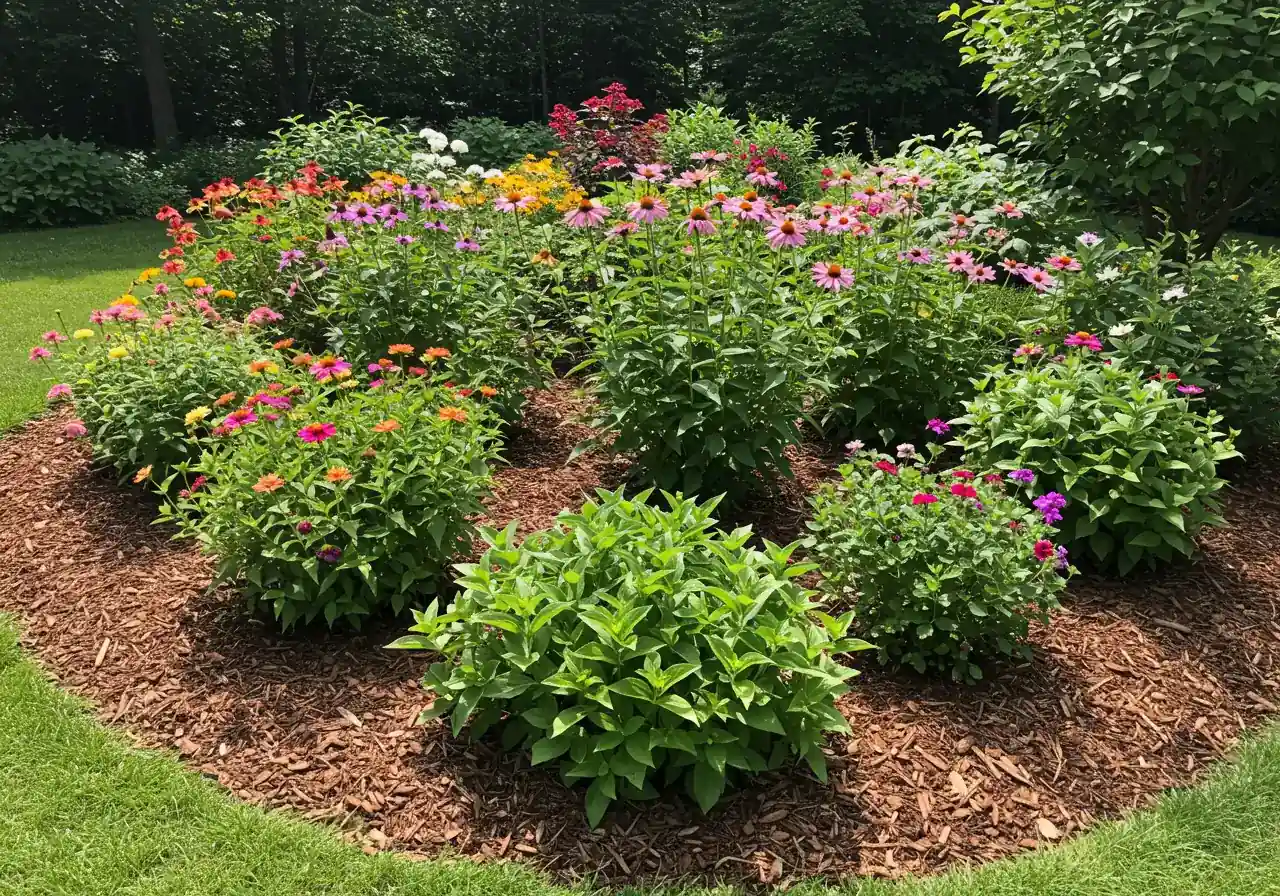
So there you have it – your roadmap to keeping your Ottawa garden looking groovy and feeling great, even when the summer sun brings the sizzle! We know tackling everything from sticky humidity to stubborn clay soil can feel like a challenge sometimes. But remember, smart gardening isn't about fighting the elements, it's about working with them.
By focusing on the essentials – like deep, efficient watering, the magic of mulch, gentle feeding for your annuals and perennials, and being a little proactive with pest patrol – you can prevent most garden grief. These strategies work wonders for soil health and keep your plants resilient, whether you're nurturing flower beds in Kenmore, perfecting your landscape in Manotick, or maintaining a lush lawn in Nepean or Embrun.
Don't feel overwhelmed! Even small, consistent efforts make a big difference. The goal is to enjoy your outdoor space, not stress over it. If you find yourself needing an extra hand with lawn care, garden maintenance, or bigger landscaping services, remember we're just a call or click away, serving communities all around Ottawa. Check out our about us page to learn more about our team. Now go forth, enjoy the sunshine, and keep that garden happy!

